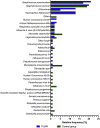Pathogen spectrum of community acquired pneumonia in people living with HIV (PLWH) in the German CAPNETZ-Cohort
- PMID: 37423969
- PMCID: PMC10811115
- DOI: 10.1007/s15010-023-02070-3
Pathogen spectrum of community acquired pneumonia in people living with HIV (PLWH) in the German CAPNETZ-Cohort
Abstract
Objectives: The objective of this study was to identify the pathogen spectrum of community acquired pneumonia in people living with HIV (PLWH), and to compare it with a matched HIV negative group in order to reassess therapeutic strategies for PLWH.
Methods: Seventy-three (n = 73) PLWH (median CD4 3-6 months before CAP: 515/µl; SD 309) with community acquired pneumonia (CAP) were matched with 218 HIV-negative CAP controls in a prospective study design. Pathogen identifications used blood culture, samples from the upper and lower respiratory tract (culture and multiplex PCR) and urinary pneumococcal and legionella antigen test.
Results: Although the vaccination rate among PLWH with CAP was significantly higher (pneumococcal vaccination: 27.4 vs. 8.3%, p < 0.001; influenza vaccination: 34.2 vs. 17.4%, p = 0.009), pneumococci were found most frequently as pathogen among both PLWH (n = 19/21.3%) and controls (n = 34/17.2%; p = 0.410), followed by Haemophilus influenzae (PLWH, n = 12/13.5%, vs. controls, n = 25 / 12.6%; p = 0.850). Staphylococcus aureus was found equally in 20.2 and 19.2% in PLWH and controls, but infection or colonization could not be distinguished. Mortality during 6-month follow-up was significantly higher for PLWH (5/73, or 6.8%) versus controls (3/218, or 1.4%), however with lower case numbers than previously reported. Typical HIV-associated pathogens such as Pneumocystis jirovecii were found only exceptionally.
Conclusions: Our study underscores the persistent clinical burden of CAP for PLWH. From pathogen perspective, empirical antibiotic treatment for CAP in PLWH on antiretroviral therapy should cover pneumococci and Haemophilus influenzae and may be adopted from valid common recommendations.
Keywords: CAP; Community acquired pneumonia; Empirical antibiotic treatment; HIV; PLWH; Pneumonia.
© 2023. The Author(s).
Conflict of interest statement
Some of the authors have conflicts of interest. If the manuscript is accepted for publication by Infection, these will be specified in detail.
B.T. Schleenvoigt received fees and financial support from the Central German Working group HIV e. V., Gilead, MSD, Janssen-Cilag, Pfizer, CRM, Falk, AstraZeneca, ViiV, AIDS help Potsdam, AIDS help Dresden and Merck outside of the present work. G. Barten-Neiner received funding for CAPNETZ from German Lung Center (DZL) and Grants from Pfizer. F. Voit received fees and financial support from B. Braun Melsungen AG, MSD and Gilead outside of the present work. C. Boesecke received financial research grants from DZIF, NEAT ID, Hector foundation and honoraria from Abbvie, MSD, JnJ, Gilead and ViiV outside of the present work. M. W. Pletz received financial research support from Infectopharm and Pfizer and honoraria from MSD, Pfizer, Shionogi, Bayer, Sanofi, GSK, Thermofisher and Roche outside of the present work. M. Witzenrath received financial research support from DFG, Bundesministerium für Bildung und Forschung, Deutsche Gesellschaft für Pneumologie, European Respiratory Society, Marie Curie Foundation, Else Kröner Fresenius Stiftung, Capnetz Stiftung, Bayer Health Care, Biotest and honoraria from Astrazeneca, Insmed, Chiesi, Novartis, Teva, Actelion, Boehringer Ingelheim, GSK, Biotest, Bayer Health Care, Pantherna, Pherecydes, and Inflarx outside of the present work. C. Stephan received honoraria from Gilead, MSD, Janssen-Cilag, AbbVie, ViiV and TAD outside the present work. None competing interests for J. Ankert, N. Suttorp, C. Hoffmann, D. Stolz, G. Rohde, A. Essig, M. Panning, J. Rupp, O. Degen.
Figures



References
-
- Schleenvoigt BT, Rupp J, Rohde G, Rockstroh JK, Fatkenheuer G, Pletz MW. Strategies for the treatment of community-acquired pneumonia in HIV-positive patients. Pneumologie. 2017;71(4):207–214. - PubMed
MeSH terms
Substances
Grants and funding
LinkOut - more resources
Full Text Sources
Medical
Research Materials
Miscellaneous

